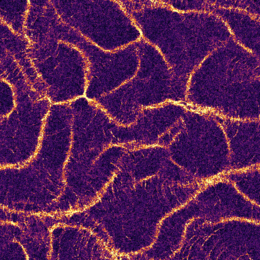Emergence of coexisting ordered states in active matter systems
Lorenz Huber*, Ryo Suzuki*, Timo Krüger*, Erwin Frey+ and Andreas Bausch+

Life relies on the emergence of order. Understanding this unique ability of living organisms to self-organize their constituents into functional ensembles is the declared central objective of active-matter physics. Recently, several breakthroughs have demonstrated that principles of active matter are indeed capable of describing the emergence of robust types of macroscopic order, such as topological or defect-dominated states in cells or tissues. Living active systems are not only robust, they also display a degree of malleability. Inside a cell, for instance, the actin cytoskeleton and actin filopodia exhibit different types of intrinsic order, although they are made from the same building blocks. It is as yet unclear how self-organization into functional units enables such ‚multi-tasking’ capabilities to emerge.
For physical systems in thermal equilibrium, a profound understanding of self-organisation processes, including the formation of lipid bilayers, phase separation, and phase transitions, is already available. Constrained by the Gibbs phase rule, all these disorder-order transitions obey the principle of universality, which asserts that the major features of these emergent phenomena can be deduced from a few relevant aspects of the microscopic interactions, most importantly their symmetry. For critical phenomena, this principle successfully explains why phase transitions can be classified into only a few universality classes.
We adopted a two-pronged approach, combining experiment and theory. Employing theactomyosin motility assay, we slightly modified the microscopic interactions of its constituent actin filaments by adding a depletion agent. This led to a cardinal change in the global symmetry of order from polar clusters to nematic lanes. Based on realistic assumptions with regard to the interacting constituents, we developed a computational model that fully reproduces local and global properties of the experimental findings.
In our work, we show that active matter can flout this principle of universality and is not compatible with the Gibbs phase rule. To our surprise, we find that, in the actomyosin system, fundamentally conflicting symmetries – polar and nematic order – can coexist, in the simultaneous presence of a disordered phase. This new phenomenon with local symmetries fluctuating between polar and nematic order, relies on sufficiently weak local interactions that display a divalent symmetry character. Contrary to the universality paradigm, subtle details of the local symmetry do not become irrelevant at macroscopic scales, but are amplified instead, such that the macroscopic symmetry becomes a self-organized, emergent property of the system. The three-fold coexisting state exists for a broad range of parameters and has fundamental implications for structure formation processes found in living cells or tissues, which often relies on a small set of identicalbuilding blocks.
Related Links
- Science 361, 255-258 (2018): Emergence of coexisting ordered states in active matter systems
- Physik Journal 11, 22 (2018): Ordnung aus Unordnung
- LMU press release (English)

